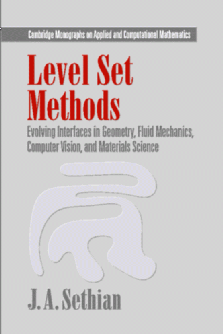OVERVIEW
APPLICATIONS
INTERACTIVE APPLETS
HISTORY OF THE METHODS/FLOW CHART
PUBLICATIONS
EDUCATIONAL MATERIAL '
ACKNOWLEDGEMENTS
ABOUT THE AUTHOR/CV
Copyright:
1996, 1999, 2006
J.A. Sethian
Level Set Methods
Evolving Interfaces in Geometry, Fluid Mechanics, Computer Vision, and
Materials Science
J.A. Sethian, Cambridge University Press, 1996
Cambridge Monograph on Applied and Computational Mathematics

Overview
This first edition book is an introduction to level set methods, which are numerical techniques for analyzing and computing interface motion in a host of settings. The numerical techniques can be used to track three-dimensional complex fronts that can develop sharp corners and change topology as they evolve. The text includes applications from physics, chemistry, fluid mechanics, combustion, image processing, material science, seismology, fabrication of microelectronic components, computer vision and control theory. The book is intended for mathematicians, applied scientists, practicing engineers, computer graphic artists, and anyone interested in the evolution of boundaries and interfaces.
The text is an equal blend of theory, implementations, and applications areas, including detailed descriptions of the appropriate numerical schemes.
Comparison with new edition
There is a new edition of this book, available in both hardback and paperback, entitled Level Set Methods and Fast Marching Methods. This new book includes everything in the first edition, plus a large collection of new topics. For details, go to Level Set Methods and Fast Marching MethodsTable of Contents for First Edition
-
PART I: EQUATIONS OF MOTION FOR MOVING INTERFACES
- Stability of Fronts, Total variation, Role of curvature and Entropy conditions
- The Time-Dependent Level Set formulation
- Topological Change, Curvature Terms, and Multidimensionality
- The Stationary Level Set formulation
- Conversion to Static Hamilton-Jacobi Equation
-
PART II: APPROXIMATION SCHEMES FOR LEVEL SET EQUATIONS
-
Traditional Techniques:
- Marker/String Methods
- Volume-of-Fluid/Cell Methods
- Hyperbolic Conservation Laws:
- The Wave Equation, Characteristics, Schocks, and Entropy Conditions
- Weak Solutions, Flux Conditions, and Riemann Problems
- Schemes for the Level Set Equation
- Convex Schemes: First and Second Order
- Non-Convex Schemes: First and Second Order
- Boundary Conditions and Initializations
- A Hierarchy of Fast Level Set Methods
- Parallel Algorithms
- Adaptive Mesh Methods
- Fast Narrow Band Methods
- Extensions to the Basic Method
- Masking, Sources, and Sinks
- Discontinuous Speed Functions and Sub-grid Resolution
- Multiple Interfaces and Triple Points
-
Traditional Techniques:
-
PART III: VISCOSITY SOLUTIONS, HAMILTON-JACOBI EQUATIONS, AND FAST
MARCHING METHODS
- Viscosity Solutions of Hamilton-Jacobi Equations
- Fast Marching Methods
- How to solve the Eikonal Equation on a 200x200x200 grid in under 30 seconds
-
PART IV: APPLICATIONS
- Motion of Curves and Surfaces under Curvature
- Sintering of Materials
- Grid Generation: Two- and Three-Dimensional Body-Fitted Grids
- Image Enhancement and Noise Removal
- Combustion: Flame Stability under Exothermic and Vortical Effects
- Crystal Growth and Dendritic Solidification
- Two-Fluid Flow, Motions of Thermals, Role of Surface Tension
- Shape Detection and Recovery in Medical Imaging
- Shape Recognition: Optical Character Recognition and Neural Nets
- Shape Offsetting in CAD
- Shape-from-Shading in Computer Vision
- Photolithography Development in Semi-Conductor Manufacturing
- Computing Optimal Paths on Networks
- Construction of Geodesics on Surfaces
- Seimsic Travel Times: Computing First Arrival Times
- Robotic Navigation with Constraints
- Etching and Deposition in Semi-conductor Manufacturing